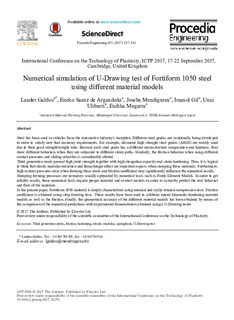Title
Numerical simulation of U-Drawing test of Fortiform 1050 steel using different material modelsAuthor
Version
Published version
Rights
© 2017 The AuthorsAccess
Open accessPublisher’s version
http://dx.doi.org/10.1016/j.proeng.2017.10.751Published at
Procedia Engineering Vol. 207. Pp. 37-142, Noviembre.xmlui.dri2xhtml.METS-1.0.item-publicationfirstpage
137xmlui.dri2xhtml.METS-1.0.item-publicationlastpage
142Publisher
Elsevier Ltd.Keywords
Third generation steels
Friction
Hardening
Elastic -modulus ... [+]
Friction
Hardening
Elastic -modulus ... [+]
Third generation steels
Friction
Hardening
Elastic -modulus
Springback
U-Drawing test [-]
Friction
Hardening
Elastic -modulus
Springback
U-Drawing test [-]
Abstract
Steel has been used in vehicles from the automotive industry's inception. Different steel grades are continually being developed
in order to satisfy new fuel economy requirements. For examp ... [+]
Steel has been used in vehicles from the automotive industry's inception. Different steel grades are continually being developed
in order to satisfy new fuel economy requirements. For example, advanced high strength steel grades (AHSS) are widely used
due to their good strength/weight ratio. Because each steel grade has a different microstructure composition and hardness, they show different behaviors when they are subjected to different strain paths. Similarly, the friction behavior when using different contact pressures and sliding velocities is considerably altered.
Third generation steels present high yield strength together with high elongation capacity and strain hardening. Thus, it is logical to think that elastic modulus reduction and Bauschinger effect are important aspects when stamping these materials. Furthermore, high contact pressures arise when forming these steels and friction coefficient may significantly influence the numerical results.
Stamping forming processes are nowadays usually optimized by numerical tools such as Finite Element Models. In order to get reliable results, these numerical tools require proper material and contact models in order to correctly predict the real behavior and flow of the materials.
In the present paper, Fortiform 1050 material is deeply characterized using uniaxial and cyclic tension-compression tests. Friction coefficient is obtained using
strip drawing tests. These results have been used to calibrate mixed kinematic-hardening material models as well as the friction. Finally, the geometrical accuracy of the different material models has been obtained by means of the comparison of the numerical predictions with experimental demonstrators obtained using a U-Drawing tester. [-]
Collections
- Articles - Engineering [745]





















